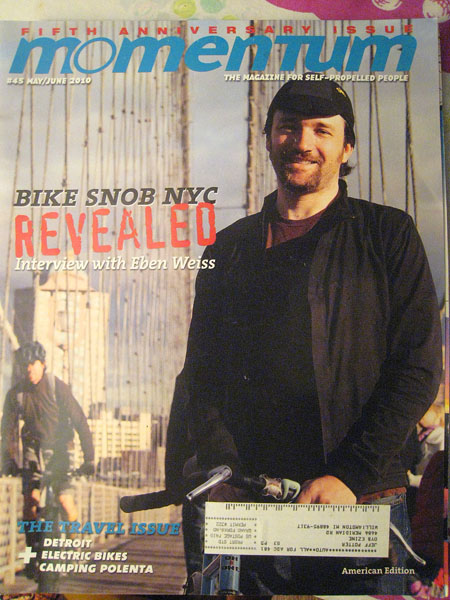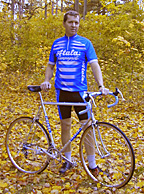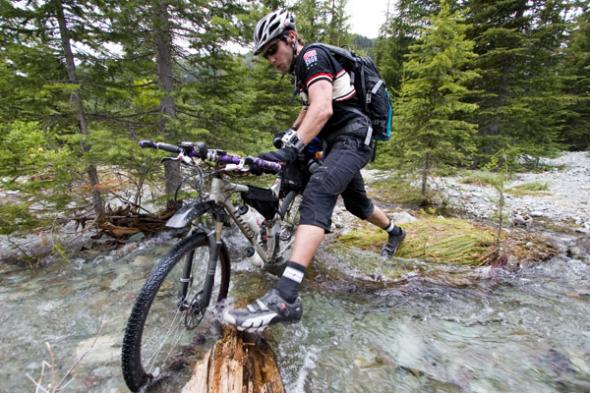It seems to me that helmets have entered a new phase. Actual safety is a totally different topic from sociology. I think the social side is more interesting than the safety side. For instance, helmets are now so well-accepted that they’ve lost a lot of their totem power. What, safety has aspects of myth, symbol and ritual? Yes, and what fun it is to ponder them.
Helmets are still caught up in identity issues and fashion. The bike isn’t totally normalized yet in the US. Helmets are part of the bike’s alien Other assignment along with lycra, discomfort and exotic materials. Bike racers and serious bikers wear helmets, but I just ride around, so I’m not a biker. Once bikes become normalized all their accessories will be, too. And when they’re socially misused it won’t be because someone is “a biker,” but only because they’re clueless.
Then there’s the “left behind” aspect. Biking is booming in the US in the urban youth demographic — for socializing and utility. Maybe half wear helmets and basically no one wears lycra.
The helmet-nagging side of biking is nearly past. Shrinking. The war is over.
There’s no helmet-nagging at big social bike party rides. There’s no place for it. If someone nagged they would be ID’ed as “boring” and the person would ignore them and turn away to someone interesting. If someone tried organizing the group, making rules, handing out waivers, beyond whatever extent seemed “cool,” the group would flow away from the “hassle” and re-assemble across the street. (Some structure is readily accepted, other is not.)
This is one of the key aspects of freedom: The power to ignore a nag.
People know about helmets. If they feel like it, they wear one. Some do, some don’t. The attempt to coerce is avoided like the plague. Socializing flows away from that impulse.
People also know about safety. Many who operate chainsaws will sensibly “armor up” and thank the heavens for kevlar and our modern age of safety. Yet some of these same people will coast down a hill on a bike with hair flying in the breeze. Are they nuts?
Is there a movement to ticket chainsaw users who don’t use safety gear? Businesses require safety today. Sometimes custodial gov’t and rules seem helpful, sometimes not.
It’s worth considering that an interest for something like a helmet law for kids might signal social interest in kids beyond the helmet. A town enacting such a law might signal a readiness to “Portlandize” in other ways. It might be the first step to a safe streets initiative, or a gungho attitude to making good fun bike routes to school for kids, or a resurgence of Parks&Rec funding. The attitude of “no bike laws” can be part of a “bikes aren’t worth considering” sentiment (and neither are kids or parks, and that school tax is awfully high). Policy-makers are savvy to such signals. They can mean more than their face value.
Helmets are just one part of bike policy. Policy, though, moves forward as part of a process of normalization. When bikes aren’t normal, policy fails. Once bikes are normal then helmet laws and lights-at-night laws can finally carry no extra baggage. It becomes “whatever.” Like seat-belts.
(Then you get outliers like loud-pipes motorcycling where needless risk becomes part of an identity: and then even police officers can vote to repeal helmet laws. Helmets in some areas are acquiring MORE symbolism. Risky or obnoxious behavior can be part of the ecstatic pressure-release from a soul-damaging job or job attitude.)
Tim Blumenthal, who has honchoed nat’l-sized bike orgs of most every kind in the US, says the hope for biking definitely comes from the non-lycra group. …That’s code for “helmet optional,” obviously. (Yet it’s not the “no lights at night” crowd. Finding yourself out past dark yet still needing to bike home is a problem that can often be solved safely enough. But lights have caught on easier than helmets. They haven’t been burdened psychically. If you’re in one a bike-lights required town, a ticket for being caught out after a race without lights is still frustrating.)
It’s not just the “biking is dangerous” reaction to helmets that dissuades people from riding. There’s a more potent subconscious variant which goes: Helmets are a good idea. I don’t wear a helmet. So I don’t bike. …An awful lot of non-bikers think bike helmets are smart. And they can also be part of why they don’t bike! It’s not an overt refusal or a sense of danger. It’s a thoughtless reflex of logic that switches the wrong way for participation. And so US bike bosses have shot themselves in the foot, are boxed in a corner. It might now require more kinds of people — such as car drivers, pedestrian/runners and shower-takers — to wear a helmet for the unconscious reflex to flip back the other way. Everyday usage in common head-risky activities might be needed to get such an everyday activity as biking to swing back to the no-think level that is required for mass social change.
Thankfully, time changes everything. Groups organized by deadly-dull nerds who attempted to coerce others (and screeched and fought) are fading and were never socially viable in the first place, especially for today’s gen. It was way too easy to get the wrong people involved and to go the wrong way in the helmet wars. A huge problem was that the socially inept took up the cause. No one will join something where they might get screeched at, nor will they join a socially awkward social group.
The 70’s bike boom only happened because biking was fun, cheap, and liberating. When awkward dullards took it over the next generation turned away. But the next Gen after that — today’s youth — can’t remember and might not even be exposed to The Wars. They’re growing up not so much a part of bike culture as they are of an everyday culture that now includes bikes. …Which puts helmets in the best position for whatever adoption they deserve.
As regards actual safety: so many head injuries of whatever extent don’t involve cars. Low-speed tipovers and curbs are the most common causes and places we hit our heads. (Even the agile sometimes can’t avoid head-strike in that situation.) Delicate or clumsy people might instinctively gravitate to protective gear, as might runners. People will do what they do. It’s great that the options are available. Awareness is key. Then maybe leave it at that. Parent your kids, not your peers.
I like to keep up on my calisthenics and joint mobility as I become elderly, and even do a few running, diving tumbles to see if I can. If I start noticing bone brittleness I’ll make other changes. I “suit up” as needed. But if it’s 90F and 90% humidity, I’ll opt for a big straw sombrero with side-holes over a helmet, because the 100% certainty of heat-misery outweighs the .0001% risk of skull-crack.
Then there’s bike design. I’ve had bikes where when I’m bumped or there’s some kind of nervous bobble I feel the bike becoming unstable. But I’ve had one that felt like a tank. It was light and agile yet if anything happened it was rock solid. It never shimmied on a downhill. It didn’t mind being run off the road into a ditch. And people could crash into it, wreck its wheels out from under it and it stayed steady. More bikes like that should be made. I have a newer bike now, from the new style of design. I’m a bit new to it but I notice that though it handles nicely, when I’m bumped around on it, or surprised by something, that it’s slightly sketchier. I don’t know why. Is it the long stem? Shorter front-center? Can’t put my finger on it. But finding a bike that makes you feel confident seems key. …Even if the confidence is just “hocus pocus.” If you feel solid on a bike just watch the debunked “magic” happen and enjoy trouble staying away.




